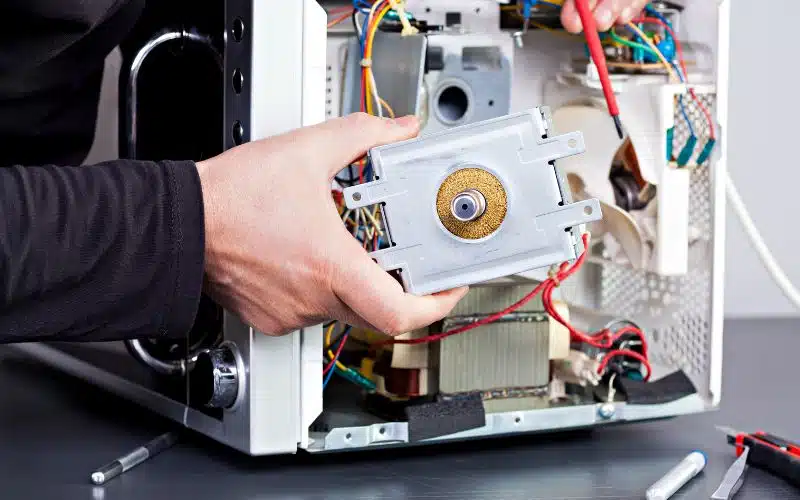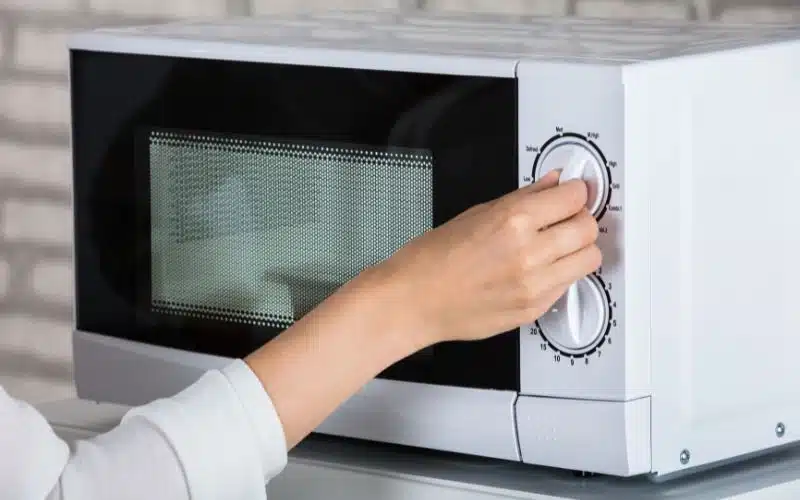Are you worried that your hot microwave is a safety hazard waiting to happen? It is inconvenient to be unable to freely move around your microwave when it is in use because it is burning hot on the outside.
Not only is it frustrating for you, but for any other person who comes within range of your microwave. In this article, you will find out why your microwave has a high exterior temperature.
Excess heat inside your microwave transfers to the outside cover and makes it hot. Heat accumulates inside your microwave in a tight space that prevents proper ventilation. Internal components like the fan or magnetron can malfunction, leading to abnormal heat. This hotness leads to injuries and even permanent damage to the microwave.
In this guide, I will explain how you can tell when the hotness of the microwave cover becomes a cause for concern and when it isn’t. By the end, you will be able to tell the difference.
Why Is My Microwave Very Hot on the Outside?

Your microwave is very hot on the outside because it is faulty. Generating too much heat on its exterior is not part of the microwave design. It is a sign of a fault.
When your microwave is too hot, there are many reasons for it. They fall into two groups. One, there is a fault in your microwave. And two, the extreme hotness is caused by anything but a fault.
For example, a component of your microwave could have failed, and this causes the accumulated heat. On the other hand, hotness can be the result of insufficient ventilation.
#1. Failing Magnetron
According to the FDA, the magnetron is the component that produces radiation. It ultimately heats food in the microwave.
Not to worry, the radiation waves don’t go directly to the food. They reflect and generate heat. However, the magnetron needs to be constantly cooled.
If otherwise, a malfunction can develop, and the magnetron will begin to generate heat excessively. Or worse, break down.
#2. Bad Ventilation
Placing your microwave in narrow, tight corners can cut off the air supply. Not just that, but the hot air drafted out of the microwave has nowhere to go.
This occurrence makes the microwave too hot on the outside. You must have felt the draft of warm air coming from your microwave at one time or another.
It is a standard measure for ventilation. The ventilation of your microwave is a circulatory process.
Cool air constantly comes in from behind, blows on the magnetron, and pushes steam outside. This process has to continue to keep the microwave working correctly.
However, when your microwave is too close to another appliance, warm air comes in instead of cool air.
Cabinets, walls, or narrow corners can block air vents and warm air drafts. All of these lead to poor ventilation. And that results in abnormal hotness outside your microwave.
#3. Faulty Fan
The microwave fan supports the air circulation process. You can hear the fan when your microwave is on by a low hum.
When the fan stops working correctly, the ventilation process dwindles. It makes heat accumulate and causes the microwave exterior to grow very hot.
#4. Using Microwave for Too Long with High Power
The outside will grow very hot when you use your microwave for too long at a power higher than necessary. It is not a safe way to use your microwave.
Foods that also take too long to cook produce a lot of steam. Combined with poor ventilation, this excess steam will make your microwave too hot on the outside.
According to some manufacturers, the magnetron and the light inside the microwave can contribute to unusual hotness. It happens when you use your microwave longer than necessary or too often.
Should the Microwave Feel Hot to Touch?
You should expect to feel some heat when you touch a well-functioning microwave. Some manufacturers place a symbol on the outer case to prove this.
This symbol looks like a triangle with wavy lines in it. It means “Caution, hot surface.” However, this heat can rise above average, which is when you should be concerned.
At this point, your microwave exterior does not feel warm to the touch anymore. If ignored, it could spark a fire.
The table below shows how you can tell if the heat on your microwave is normal or not.
| Normal | Not Normal |
|---|---|
| You can hold your hand down on the microwave. | You flinch immediately when you touch the microwave. |
| No matter how long contact lasts, it does not give you a burning sensation. | The briefest contact burns you. |
| Nylon material near the microwave is unaffected. | Nylon material near the microwave appears singed. |
What Are Other Signs That the Microwave Is Going Bad?
Your microwave getting too hot on the outside is just one sign that your appliance is going bad. Other signs include rattling sounds, old age, and loss of speed.
Below, I will explain these signs and more in detail.
#1. It Is Old
The design of many microwaves allows them to stay in good condition for up to 10 years.
Once your microwave is older than this, it starts to become weaker, even if it is not immediately apparent. The age of your microwave alone tells you that it is going bad.
Consider a replacement to avoid faults and inconveniences that might come with it.
#2. Burning
Stop cooking if you notice smoke wafting from your microwave and smell something burning.
Turn off the microwave because burning is a serious sign that your microwave has an urgent problem.
#3. Slow Cooking
One major appeal of a microwave is its speed in cooking food. Not only are microwaves fast, but they cook food properly as well.
But, when your microwave takes too long or even cooks food unevenly, it shows waning power.
To be sure, heat a cup of water for 120 seconds of high power. If, after that time, the water is not scalding hot, then your microwave is going bad.
#4. Rattling Sounds
When your microwave is getting weaker, one telltale sign is the sound it makes. Unpleasant, harsh noises replace the usual low hum.
This noise can result from the wrong arrangement of the fan blades. It also results from a stray chunk of food getting into the wrong place. However, replace your microwave if you cannot find the noise source.
Conclusion
No matter why your microwave is hot on the outside, keep in mind that the price of new microwaves is pretty affordable these days.
It is economical, more convenient, and safe to replace an overheating microwave. However, let experts do it for you if you choose to repair a faulty component.





